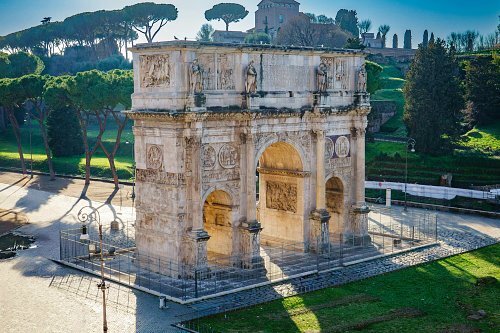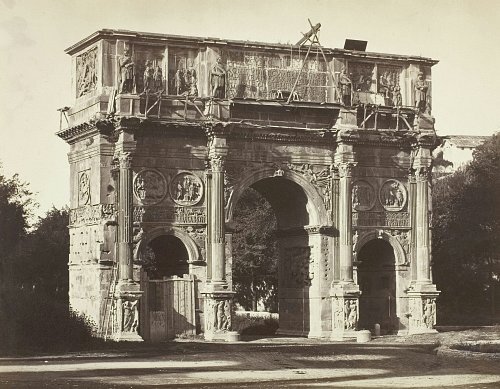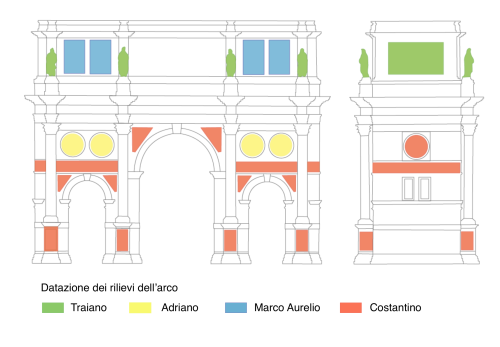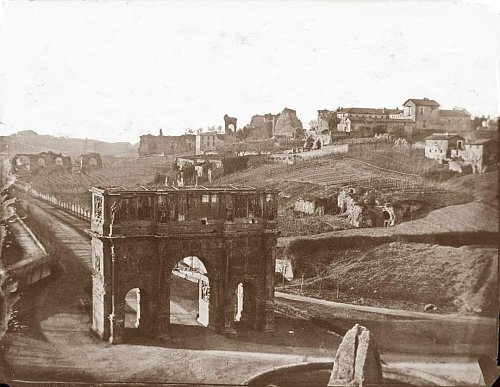Arch of Constantine and Meta Sudans
 Arch of Constantine - Aereal View
Arch of Constantine - Aereal View
The Arch of Constantine, the largest surviving tribute arch, is located on the triumphal route between the Circus Maximus and the Arch of Titus. It therefore represents much of the ideological propaganda of the Constantinian period. It was dedicated in honour of Emperor Constantine's victory over Maxentius over a bridge known as the Milvian Bridge on 28 October 312 A.D.
According to the inscription above one of its three arches, this is because this victory founded an empire; therefore, this was dedicated in celebration and also for the founding of his empire ten years earlier; that is, this was dedicated when he had been king for ten years, on 25 July 315 A.D.. The relief decoration on the marble slabs was planned and executed as part of a single design in Constantine's time, mostly using material from other royal buildings. Balanced patterns have reliefs depicting the reigns of Trajan, Hadrian, Marcus Aurelius and, in the lower part, Constantine changing the main fronts of the arch and its sides.
They changed the faces of all the emperors carved on the reliefs to look like Constantine, with a halo to show their imperial glory. The different images decorating the arch are linked by one idea: the celebration of Constantine's political plan to breathe new life into the Empire. He wanted to be seen as the new arbiter of Rome's destiny and the rightful victor over his enemy Maxentius.
To do this, he chose an ancient design strongly linked to the imperial tradition: the triumphal arch. This building was carefully constructed to tell the story of his achievements, but also included older images taken from other monuments. Such images, showing the wars and victories of the empire's great heroes, helped to prove Constantine's rule, giving confidence in his leadership and support for him in politics.
 The History of Arch of Constantine
The History of Arch of Constantine
History
Constantine I defeated Maxentius at the Battle of the Milvian Bridge on 28 October 312; this arch was dedicated in his honour by the Senate and the people of Rome. It was inaugurated in 315 during the celebrations of the Decennalia, the tenth anniversary of the reign of Emperor Constantine. Between the Palatine and Caelian Hills, it would most likely stand here, because this is the place where the Triumphal Way once ended, practically but not symbolically, before a statue – the Colossus of Nero transformed into that of the Sun God near the Colosseum.
This is one of the three triumphal arches still standing in Rome. The other two are the Arch of Titus (c. 81-90) and the Arch of Septimius Severus (202-203). Like the Arch of Titus, it was almost completely ignored by ancient writers. Most of what we know, therefore, comes from a long dedicatory inscription that runs along each of the main faces of the attic.
Although legend has it that the cross appeared at the Battle of the Milvian Bridge and that Constantine built an arch, he had not yet made any public inclinations towards Christianity. The emperor, who in 313 reaffirmed the freedom of worship for the peoples of the Roman Empire, did not attend the Council of Nicaea, which he convened and chaired in 325. Consequently, despite the controversial inscription "instinctu divinitatis" (by divine inspiration), it is most likely that Constantine did practise some form of separation between religions - probably more to do with politics than anything else.
The arch has reliefs depicting sacrifices to various pagan deities, particularly within the tondos busts of Hadrian; these deities are also found in side passages; in addition, other pagan deities are depicted on the keystones of the arch. However, of the panels reused from a monument dating from the time of Marcus Aurelius, those relating to the Capitoline Triumph and Sacrifice were omitted from the panels now in the Capitoline Museums, and thus from the ceremony so important in the state religion of paganism. In 1530, Lorenzino de' Medici was expelled from Rome for having cut out the heads from the reliefs of the Arch for his amusement, part of which was later restored in the 18th century. In 1960, the XVII Olympiad was held in Rome. The Arch of Constantine welcomed a beautiful marathon finish, warmly embraced by the triumphant Ethiopian athlete Abebe Bikila, who ran barefoot to victory.
 Arch of Constantine Architecture
Arch of Constantine Architecture
Architecture
The piers of the arches are made of square marble masonry, while the attic, which contains a usable room, is made of rubble and cement and plastered on the outside with marble blocks. Various types of white marble were used indiscriminately, mostly taken from older monuments, as was much of the architectural decoration and sculpture. The total height of the arch, including the attic, is 21 metres; it is 25.70 metres wide and 7.40 metres deep. The central arch is 6.50 metres wide and 11.45 metres high.
The architectural structure is close to the Arch of Septimius Severus in the Roman Forum, with three arches supported by columns rising from high bases. Some of the decorative motifs originate there; in fact, the victories on the spandrels of the main arch are taken from this prototype. The first order cornice is made up of straight elements reused either from the Antonine or early Severan period, completed with Constantinian copies for the projecting parts above the columns, which show more careful carving on the front than on the sides.
The Corinthian capitals, also from the Antonine period, and the shafts and bases of the columns in antique yellow marble have all been reused. Those of the pilasters behind are Constantinian copies, while the shafts of the pilasters, probably reused, were mostly replaced during the restoration in the 18th century. The crown of the central arch dates from the Domitian period, with later modifications. The archivolts of the main door, together with the smooth elements - crowns and plinths, frieze, lintel and bases of the main order, as well as archivolts and impost crowns of the side doors - date from the Constantinian period and often bear reduced mouldings set incoherently.
 Meta Sudans
Meta Sudans
Meta Sudans
Near the Arch of Constantine are the remains of the so-called Meta Sudans, a large fountain built in Flavian times. It functioned until the 5th century AD, when its drainage channels were blocked by the general filling in of the Colosseum valley.
Later, during the Fascist period, these ruins were demolished to make way for the Via dei Trionfi. Images on coins, photographs and drawings from the late 19th century, when it was demolished, all help to show what it looked like at first: a round marble base, perhaps with spaces for statues or other objects, then a conical piece with a flower or ball on top. The word "meta" comes from the shape of the target, because the object took on a conical shape, like targets in circuses, while "sudans" meant the water that came out of it.
The Meta Sudans thus acquired great urbanistic importance at an angle of the sacred boundary of Romulus' city, where two roads related to the Triumphal Way intersected and at the same time served as a meeting point for four regions of Augustan Rome. A smaller fountain had already been built on this site by Augustus, as testified by the sources and also found during recent excavations. Thus, the Flavians were able to continue the legacy of such highly symbolic monuments.
